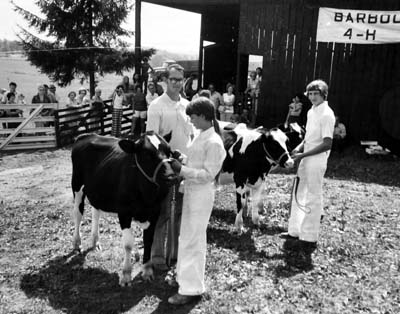“From cattle to cats”
Rural Veterinarians
By Barbara Smith

Lisa Loyd’s experiences with livestock as part of Barbour County’s 4-H program
inspired her to become a veterinarian. Courtesy of Lisa Loyd.
“I’m a direct descendant of Solomon Carpenter, the first white person known to have been born in Webster County,” Bill Carpenter says as he pulls out a heavy cedar chair and sits down.
“Another first in that area—in 1908, Dr. [Minor “Doc”] White (1888-1978) became the first licensed veterinarian in West Virginia. He practiced in Webster Springs and was a friend of my grandfather’s. He was what was then called a horse doctor,” Bill smiles. “Wanting to be licensed, he went to the proper authorities in Charleston, but they refused his request. Ohio State had opened a vet school in 1885, and the state was licensing vets, so he went there and passed the tests and got a license. Then he came back and demanded recognition in West Virginia and got it. [To learn more, see “Country Vet Doc White” by Patricia Samples Workman, Winter 1998.]
Bill Carpenter, a licensed vet, was born and raised on Miller Mountain in Webster County. “I grew up in the woods, but after I graduated from Webster Springs High School in 1960, we moved to Denver, and I decided to follow my interest in wildlife, especially wildlife diseases, so I went to Colorado State University and earned a degree in wildlife management. I also did a tour in Vietnam, and I still belong to three military organizations. After Vietnam, because I didn’t want to work for the government, which is where wildlife management is housed, I went into private practice in Elkin, Virginia, over in the Shenandoah Valley.”
Moving to Fairmont in 1978, Bill opened a clinic with one vet and a small staff. “I had what’s called a mixed practice, which means any animal at all: elephants to field mice. Why, if someone came in with a sick fly, we took care of it. The only animal we vets can’t treat is humans.”
In addition to running the clinic, Bill directed the veterinary technician program at Fairmont State College (now University). “It was a two-year associate-degree program,” he explains, “with maybe 12 or 15 students enrolling each year.” He left that position in 1996 to work full-time in his clinic.
“I’ve worked on a lot of big animals, but these days,” he says, “very few vets do farmwork. It’s easier and a lot cheaper for the farmers to give their own animals their vaccinations or whatever. They’re even doing artificial insemination and embryo transplants. There are many medications for animals that are not yet—and probably never will be—available for humans. FDA requirements just can’t be met. But cattlemen and horse owners can buy these medications at local feedstores or out of farm supply catalogs.
“By both choice and necessity, my practice became focused on small animals,” he smiles. “We switched from cattle to cats. Vets have changed, too. Veterinarians were once mostly farm boys, but now they’re mostly city girls. There were 84 in my graduating class, two of them women. Now, women vets outnumber men three to one, and sick cats outnumber sick dogs by about 55% to 45%. What used to be a matter of farm business—treating valuable cows and horses—is now a matter of taking care of beloved family members. Even horses are now pets, not animals involved in farm production,” he says.
Another area of change is that of equipment and facilities. “Unfortunately,” Bill says, “that means money. A setup for digital X-rays, for instance, will run at least $26,000, plus another $26,000 for the X-ray machine itself. The new equipment for blood work runs at least $20,000. Real estate and equipment for a whole new clinic would run at least $500,000. To make matters worse, the income for clinics hasn’t gone up, partly because clients just can’t afford advanced treatments. Clients almost inevitably have to pay the entire bill because animal insurance isn’t cost-effective. It’s easier to pay an occasional bill than to pay the insurance premiums. The bottom line for us is that a vet’s salary is only a fraction of what an M.D. makes, even though we’ve had the same time and cost of education. That reminds me of the time I was doing a Caesarian section delivery on a cow. This 20-year-old standing by watched for a while and then said, ‘Wow! You’d think he was a real doctor.’”
“But my favorite patient,” he continues, “was one of Santa Claus’ reindeer. It was back in the ‘80s, and Santa was visiting the Middletown Mall in Fairmont. One of the reindeer had come down with a respiratory infection, so I was called in to treat him—I guess it was a him. I just wish I knew which reindeer owes me a present!”
You can read the rest of this article in this issue of Goldenseal, available in bookstores, libraries or direct from Goldenseal.